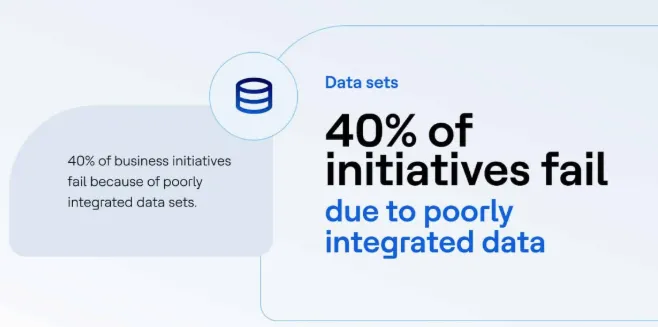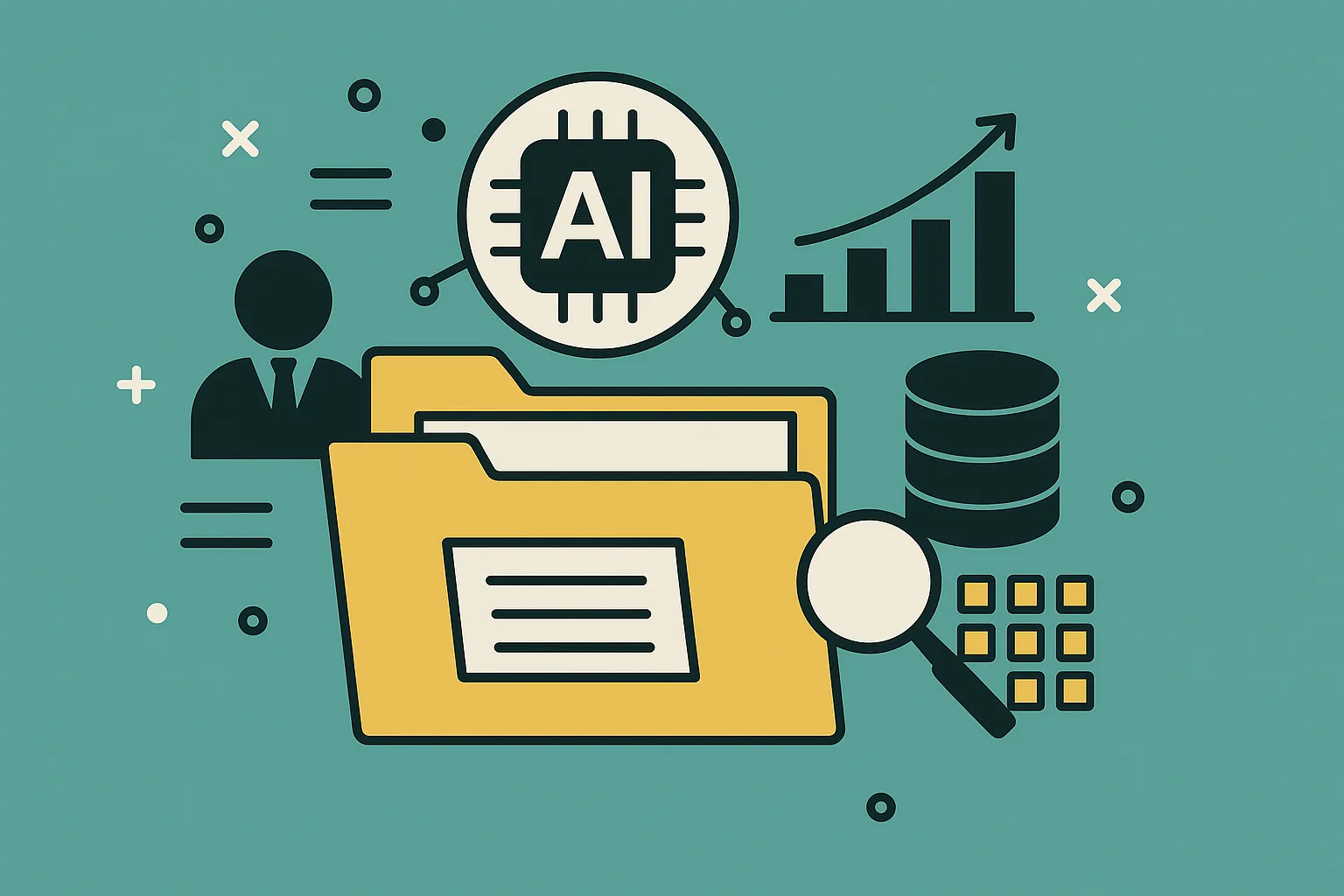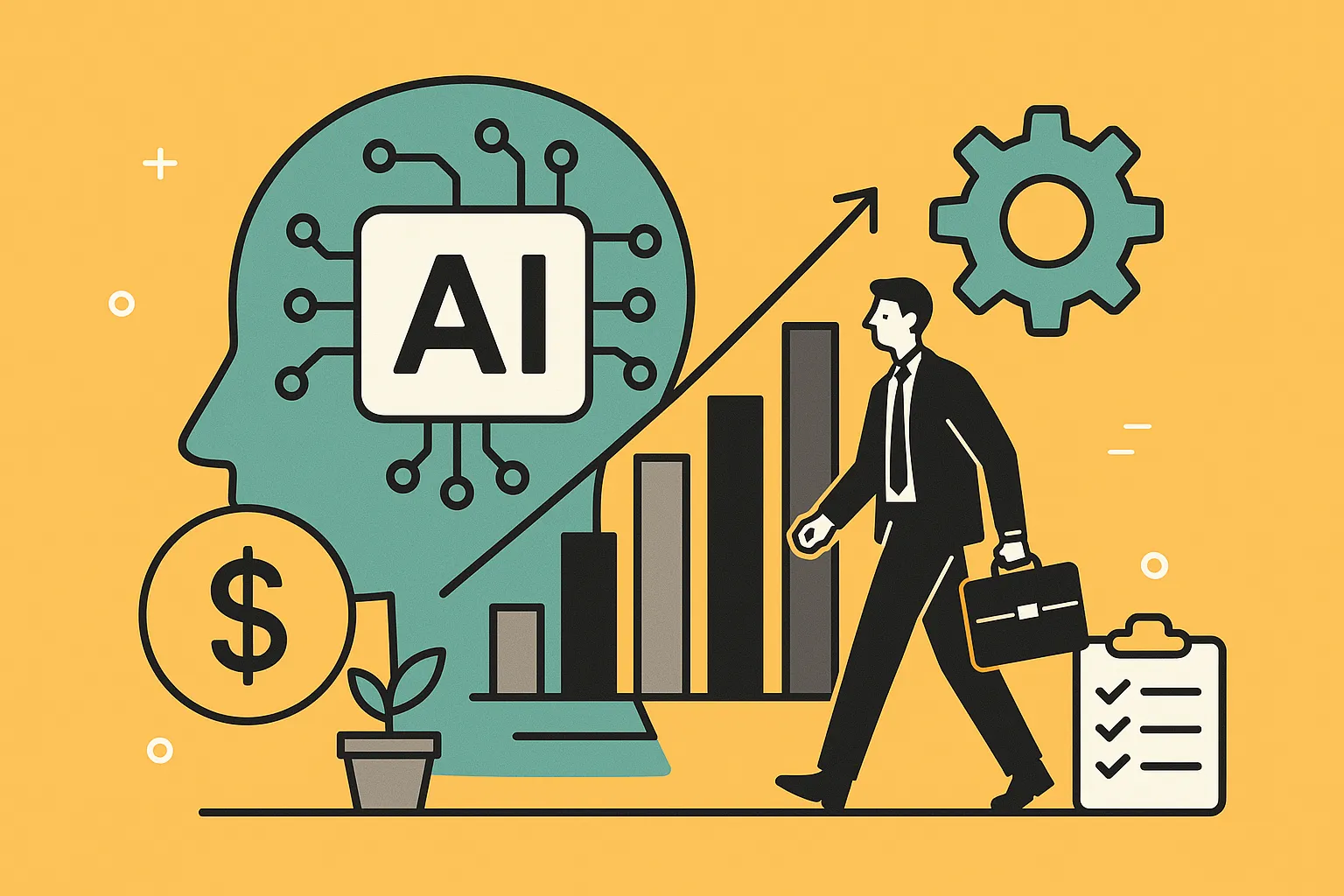Why Most AI Projects Fail and What Data Has to Do With It
Andrew Ng, one of the most influential voices in artificial intelligence, put it plainly:
“Data is food for AI. If you have bad food, no matter how good your chef is, you're going to get a bad meal.”
In 2025, that analogy has never felt more accurate, or more urgent. A recent report from S&P Global revealed that 42% of enterprises have walked away from most of their generative ai implementation efforts. That figure represents a 17% increase in failure from the previous year alone. The problem isn’t a lack of belief in AI’s potential, enthusiasm remains high. But the gap between ambition and execution is becoming harder to ignore.
So What’s Going Wrong?
In many cases, the underlying technology is not to blame. Today’s platforms and algorithms are more powerful and accessible than ever. But digital process automation, machine learning, and predictive analytics can only thrive when built on strong foundations. The real obstacles lie in data integration challenges, legacy infrastructure, and siloed teams. These issues rarely appear in a pilot report — yet they quietly derail even the most promising AI strategies.
As we discussed in our previous blog on How to Implement AI Successfully, success does not start with model selection or deployment. It starts with AI readiness: not just technical, but also organisational and strategic.
Business leaders must take a step back and ask:
Are we Truly Prepared to Scale AI?
That question goes far beyond IT departments. It requires cross-functional alignment, clear governance, and a long-term perspective on how AI will reshape automated workflows, decision-making, and customer experience.
There are three critical dimensions to evaluate:
- Data Readiness: Is your data clean, labeled, and accessible? Can it support continuous AI learning, ensure traceability, and meet regulatory compliance?
- System Readiness: Are your platforms modern and connected — or are you still operating with siloed infrastructure that stifles data-driven automation?
- Organizational Readiness: Do your teams understand how to work with AI tools? Are roles, responsibilities, and governance frameworks in place to scale ethically and effectively?
This guide outlines a six-step, strategic-first approach to AI implementation with a focus on data, systems, and culture — the core ingredients for enterprise success.
AI Readiness Framework: 6 Steps to Scale Enterprise AI Successfully
Becoming an AI-driven organization requires more than just hiring data scientists or experimenting with models. It demands a strategic, enterprise-wide approach. Below is a six-step framework to assess and build AI readiness, with each step explained in detail. This guide is tailored for executives, emphasizing the importance of data strategy and real-world examples of companies who paved the way.
1. Centralize and Connect Your Data Sources for Scalable AI
A strong AI implementation in business strategy starts with a complete inventory of data assets.
Most enterprises hold customer data in CRMs, operational data in ERPs, plus unstructured data (emails, documents) and third-party datasets. Creating an inventory means listing out all your data sources across departments. It helps you understand what data exists, where it lives, and how it’s being used. Mapping and integrating these disparate sources into a central repository (cloud data warehouse or data lake) is critical.
By centralizing data and aligning on common business entities (e.g. unified customer or product IDs), you break down silos that traditionally fragment information across departments. Siloed data leads to incomplete insights — Forrester finds 85% of executives cite incomplete datasets as a major hindrance to AI — and can doom AI initiatives before they start. In fact, 40% of business initiatives fail due to poor data integration.

Centralizing and integrating data is also key. This may involve building cloud data lakes or deploying a data fabric that connects disparate sources. The payoff is enormous: integrated data enables 360° analytics and more powerful AI.
For example, The Coca-Cola Company recently unified consumer data from over 200 countries into a global data platform. By migrating over 1 billion customer records to a single cloud service, Coca-Cola achieved a “single view” of the customer across 100+ markets.4 This broke down silos between regional teams and accelerated insights for marketing and digital process automation.
Similarly, Amazon attributes much of its success to integrating data streams (retail, web services, advertising) into a unified ecosystem accessible across the company.
Why Does This Matter?
Integrated data is the foundation of every AI use case. Without it, even the best algorithms will deliver fragmented or biased results. By inventorying all data and ensuring it can talk to each other, executives set the stage for AI to draw insights from the full picture rather than a puzzle with missing pieces.
Executive Checklist: Inventory & Integration
- Map Your Data Estate: Create a catalog of all data sources across business units (CRM, ERP, databases, spreadsheets, etc.).
- Eliminate Silos: Invest in AI implementation services or custom AI solutions like cloud data warehouses, data lakes, or data fabrics to unify disparate datasets.
- Monitor Data Gaps: Identify critical data you don’t have and consider SAP predictive analytics or external data sources to enrich your internal data (e.g., market or third-party data).
2. Align Data to with High-Impact Use Cases and Business Goals
With data in hand, tie your AI efforts to specific business use cases. Too often, companies start with trendy technology (e.g. “let’s use AI because it’s hot”) rather than a concrete problem.
A successful AI transformation “always starts with the business problem you want to solve,” as one McKinsey expert advises. By identifying high-impact challenges or opportunities in your business, you ensure AI implementation in business delivers real value. This could mean reducing fraud losses, predicting customer churn, personalising marketing, optimizing supply chains, etc., depending on your industry.
Prioritize use cases that matter to the bottom line or key goals (e.g. improving customer experience, optimizing supply chain, reducing risk). For instance, if customer retention is a top goal, focus your data efforts on building churn prediction models or personalized marketing analytics. If operational efficiency is critical, use data to find bottlenecks in production or logistics.
The alignment ensures resources are spent where they move the needle. As a bonus, when data projects demonstrate ROI, it’s easier to secure buy-in for further investments.
Amazon’s famous recommendation engine is not just a cool AI, it directly serves the business goal of increasing sales per customer. It’s been wildly successful, driving an estimated 35% of Amazon’s e-commerce revenue through personalized product suggestions. Amazon identified a use case (cross-selling to improve basket size and customer satisfaction) and applied data (purchase history, browsing behavior) to achieve that goal. The result is a virtuous cycle: data-driven recommendations lead to more sales, which generate more data, which further refines the AI.
This step is also about saying no to low-impact projects. Many companies fall into the trap of chasing trendy AI ideas that don’t fit their business model. High performers focus on a handful of custom AI solutions and do them well.
Executive Checklist: Alignment to Business
- Prioritize High-impact Use Cases: Rank potential projects by impact and feasibility. Tackle “quick wins” that demonstrate value, and ensure long-term projects align with strategic goals (market expansion, customer service, etc.).
- Connect to ROI: Require a business case for data investments. Reference industry stats or case studies to justify how a given project will create value.
- Avoid Vanity Projects: If a proposal doesn’t clearly answer “How will this make or save us money (or improve our strategic position)?”, reconsider it. Redirect efforts to proven or well-hypothesized use cases.
- Define Clear Success Metrics: For each data/AI initiative, identify upfront the business KPIs it will influence (e.g., conversion rate, churn %, supply chain cost).
3. Clean and Enrich Your Data
Even integrated data is useless if it’s poor quality or untrustworthy. This step is about data enrichment, quality, and governance — essentially, treating data as a high-grade asset. Bad data doesn’t just slow down your AI team; it can lead to incorrect insights and costly mistakes. For the C-suite, these aren’t technical issues — they’re business risks and inefficiencies.
Data cleaning means establishing processes to continuously correct errors, remove duplicates, and standardize information across the company. For instance, ensure customer names, product codes, and other key fields are consistent in every system. Many companies implement AI implementation services like master data management (MDM) solutions to create one “golden record” for critical entities.
Enrichment goes a step further: enhancing your data with additional context. This could mean appending demographic data to customer records, adding IoT sensor metadata (location, conditions) to operational logs, or integrating third-party data (like market indicators) to enrich internal data. Enriched data gives AI models more signal and less noise.
Executive Checklist
- Implement Quality Controls: Set up automated data profiling and cleansing tools to catch errors. Track data quality metrics (completeness, accuracy, timeliness) on an executive dashboard.
- Enrich Critical Data: Identify where adding external or additional internal data could boost insight (e.g., enriching customer profiles with social media sentiment or credit scores). Invest in data enrichment partnerships or services if needed.
4. Assess and Upgrade Infrastructure for AI
AI initiatives strain infrastructure in ways traditional IT systems might not handle. Executives should therefore critically assess whether their current technology stack can support the demands of AI, and plan upgrades where needed.
Key considerations include:
- Data processing capacity
- Storage
- Computational power
- MLOps (Machine Learning Operationscapabilities for model deployment and monitoring)
Modern AI often requires processing real-time data streams as well as huge historical datasets. Can your systems ingest and analyze streaming data (from IoT sensors, web events, etc.) in real time? If not, you may need to implement streaming platforms (e.g. Apache Kafka) and scalable databases.
Another requirement is the ability to train large models efficiently – this means access to powerful GPUs or distributed computing clusters, and plenty of storage for big data. Many legacy on-premise data centers struggle here, which is why cloud computing has become a backbone for AI at many firms.
This is especially important for companies pursuing generative AI implementation or custom AI solutions at scale. Without adequate infrastructure, even the most promising AI models can falter in deployment or fail to deliver expected ROI. AI implementation services often include an infrastructure audit, helping organizations align their hardware and platforms with modern demands.
5. Build a Data-Driven Culture and Strengthen AI Governance
Technology alone doesn’t guarantee AI success — people and culture make the difference.
AI readiness requires breaking down organizational silos just as much as data silos. Executive sponsorship and cross-functional collaboration are critical to turn pilot projects into company-wide capabilities. C-suite leaders should actively cultivate a data-driven culture: one that encourages experimentation with AI, collaboration between business and technical teams, and continuous learning/upskilling in analytics.
Firstly, ensure there is top-level championship for AI. When the CEO, CFO, and other C-suite members frequently articulate AI’s importance in strategy, it signals to the entire organization to prioritize and embrace these initiatives.
Investing in upskilling and data literacy across the workforce is another pillar of a data culture. Front-line employees and managers don’t need to be AI experts, but they should be conversant in data analytics and comfortable interacting with AI-driven tools.
Consider instituting training programs or an internal “Data Academy.” Airbnb did this with its in-house “Data University,” a program to empower every employee – not just analysts – to use data in decision-making. This initiative democratized data access and analysis at Airbnb, creating hundreds of mini-analysts in different departments and ensuring that when advanced AI insights are rolled out, employees have the context to understand and leverage them.
Upskilling can range from basic data literacy courses for all staff, to advanced machine learning training for key developers. Some firms even rotate talent: moving a rising business manager into a data science team for a stint and vice versa, to create “bilingual” individuals who bridge the gap between AI and business.
AI governance and ethics should also be part of the culture from day one. Executives should set the tone that AI will be used responsibly. This might involve establishing an AI ethics committee or including ethical guidelines in the AI project.
Microsoft, for instance, formed an internal AI ethics board and a CoE to guide responsible AI development. At a practical level, this means when cross-functional teams plan an AI project, they consider questions like: Are we using customer data transparently? Could our model inadvertently disadvantage any group of customers? Having diverse teams helps here too – a cross-functional, cross-demographic team is more likely to catch ethical blind spots.
By building these considerations into your culture, you not only avoid scandals or compliance violations, but also build trust in your AI systems among customers and employees.
Crucially, executives must institute strong data governance. Data governance is the framework of policies, standards, and roles that ensure data is accurate, secure, and used appropriately. It’s as much about people and process as technology.
A 2022 MIT survey of Chief Data Officers found data governance is their #1 responsibility, with 51% of CDOs citing “establishing clear and effective data governance” as a primary mandate. This includes setting data ownership (who “owns” customer data? finance data?), quality standards, and compliance procedures.
With data privacy regulations now covering roughly 75% of the world’s population by 2024, governance isn’t optional. Regulations like GDPR, CCPA, and others impose hefty penalties for mismanaging personal data. But beyond compliance, good governance builds trust.
In fact, in a recent article, Gartner highlighted the importance of data governance as one of three key steps for data readiness. For organizations adopting AI implementation in business, clear governance helps ensure that models remain auditable, explainable, and fair.
.png)
Finally, lead by example in data-driven decision making. When executives themselves consistently use data dashboards, cite data insights in meetings, and remain open to AI-driven recommendations (even when they challenge intuition), it reinforces the culture.
Foster an environment where IT, data science, and business units work as “one team” on AI. Recognize and reward collaboration and knowledge-sharing. Break the mentality of “IT versus business” – in an AI company, these become shared stakeholders in success. And remember that organizational learning is key: each AI pilot (successful or not) should leave lessons behind and increase the company’s collective AI savvy.
6. Pilot, Monitor, and Scale AI Carefully
After laying the groundwork (data, infrastructure, culture), it’s time to implement AI solutions — but wise leaders do so in a phased, experimentation-driven manner. Rather than betting the farm on an untested AI project, the strategy should be: pilot, refine, and then scale. This approach manages risk and allows the organization to build confidence and expertise with each success.
Start with small pilots or proof-of-concepts (PoCs) targeting the use cases identified earlier. Define clear metrics for success (KPIs) at the pilot’s outset – for example, “can we reduce fraudulent transactions by at least 50% in this business unit within 6 months?” or “increase forecast accuracy by 20% for product X.” By measuring outcomes against these targets, you can objectively decide whether to iterate or pivot.
Crucially, monitor AI performance continuously during and after the pilot. AI models are not “set-and-forget” — they require ongoing oversight. Track the pilot’s KPIs in real time with dashboards. If it’s a customer-facing AI (say a recommendation engine on your website), monitor engagement metrics and collect user feedback.
Many companies set up automated monitoring for model accuracy and data drift. For instance, after deploying their churn prediction model, the industrial supplier would monitor how accurately the model’s predictions translate into actual retained revenue each quarter, and they retrain the model as customer behavior evolves. This iterative improvement loop is vital. When Zillow’s pricing model failed, one issue was lack of prompt adjustment when the housing data distribution shifted — areminder that continuous monitoring could have triggered an earlier correction.
Once a pilot hits its targets (or shows a positive trend), plan the scale-up deliberately. Scaling can mean expanding the AI solution to additional business units, higher volumes, or more complex use cases. It’s wise to scale in stages. For example, after Coca-Cola saw success in a few markets with AI forecasting, they could extend it to more regions while ensuring the necessary infrastructure (data integration from those regions, training of local staff to use the new system) is in place.
When scaling, also consider process changes — does staff need new training to work with the AI tool? Do SOPs need updating? AI might recommend actions, but humans in the loop need to trust and act on them. This is where the earlier steps on culture and trust pay off.
Engaging with AI implementation services during this phase can support organizations in building scalable, enterprise-grade solutions and developing a governance model that works in production. Many companies also deploy custom AI solutions in stages, starting with a single function or region before enterprise-wide rollout. These strategies are especially helpful for generative AI implementation, where complexity and oversight requirements are higher.
Finally, institutionalize a feedback and iteration process. Even at scale, AI solutions need periodic tune-ups. Set up a cadence (e.g. quarterly model review, monthly KPI review) where the team assesses if the model’s performance is holding steady, and if business metrics are being met. If not, investigate: Has the data input changed? Has competitor behavior or customer preference shifted (requiring the model to be retrained on more recent data)? Use this feedback to continuously improve the AI system.
Scaling AI is a journey, not a one-time project.
By piloting small, proving value, and gradually expanding, you mitigate risks and learn what works in your organizational context. Make sure you have mechanisms to monitor outcomes and gather feedback at every stage. When each successful pilot is scaled, it not only delivers business results but also builds momentum and organizational buy-in for the next AI project.
Over time, these iterations compound, and AI begins to infuse multiple facets of the business — delivering a competitive advantage that is difficult to replicate.
What It Really Takes to Scale AI in Your Organization
Adopting AI at scale is a strategic transformation that touches data, technology, people, and processes.
As leader, your role is to orchestrate these six steps holistically: ensure data is unified and high-quality, focus AI efforts on business value, fortify the tech infrastructure, nurture a collaborative and data-savvy culture, and manage the rollout of AI initiatives with diligent oversight.
Remember that AI readiness is not a one-and-done checklist but an ongoing capability. The business environment and technologies will continue to evolve. However, by investing in the fundamentals — data and culture especially — your organization builds a resilience and agility to adopt new AI developments faster than competitors.
In the end, AI readiness enables your company to convert cutting-edge AI innovations into tangible business outcomes repeatedly and sustainably. That is the real promise of AI — and with the strategic framework above, it’s an achievable goal rather than a vague aspiration.
.webp)




